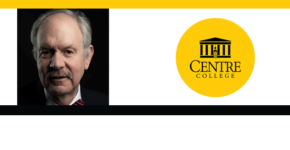 Taxpayers are told to ante up to keep sports teams in their cities, but is it worth it?
Taxpayers are told to ante up to keep sports teams in their cities, but is it worth it?
Bruce Johnson, James Graham Brown professor of economics at Centre College, examines this question.
Bruce K. Johnson is the James Graham Brown Professor of Economics at Centre College, where he has taught since 1987. He became interested in sports economics when he developed a baseball salary model as a teaching example for his econometrics class. It led eventually to a chapter in a Brookings Institution volume on the economics of baseball in 1992.
To answer the question of whether sports public goods could justify large stadium subsidies, Johnson teamed up with Centre alumnus and environmental economist John Whitehead to adapt the Contingent Valuation Method (CVM) survey technique to sports public goods. Their analyses of a new basketball arena and a minor league baseball stadium in Lexington, Kentucky demonstrated the feasibility of CVM in sports. They teamed up with Peter Groothuis and Michael Mondello, respectively, for the Pittsburgh and Jacksonville studies.
Their subsequent research on sports public goods has involved collaborators in Canada and Germany, with the former financed by the Alberta Gaming Research Institute and the Social Sciences and Humanities Research Council of Canada.
The one exception my coauthors and I found where the value of sports public goods exceeded the subsidy costs was in Canada. We conducted nationwide telephone surveys before and after the 2010 Winter Olympic Games in Vancouver, BC. We found that willingness to pay for government to identify and train young athletes with the potential to compete for medals in Winter Olympic sports was many times the actual subsidy. The difference from the stadium results was that the amount of the actual subsidy cost was much lower than the typical stadium subsidies and the public goods had nationwide appeal.
Johnson has also written on sports economics for general audiences with op-ed articles in USA Today, the Atlanta Constitution, Cincinnati Enquirer, Minneapolis Star Tribune, Orlando Sentinel, and others. He served as Vice President of the North American Association of Sports Economists 2010-12.
Johnson has won four teaching awards at Centre and was Faculty President 2013-2016. He has twice been a Visiting Professor at the University of Virginia.
He chairs the Consensus Forecasting Group, the nonpartisan panel which produces the official forecast of state government revenues for the Commonwealth of Kentucky.
He earned his B.A. at Transylvania University and his Ph.D. in economics at the University of Virginia.
Benefits of Public Goods Do Not Justify Stadium Subsidies
When sports teams ask their cities for new stadiums, taxpayers hear an implicit threat. “Build it, or they will go.” Oakland recently said no to its baseball team, which will move to Las Vegas.
Did Oakland win or lose? The answer requires benefit cost analysis. But it’s tricky because sports produce public goods. Unlike private goods, such as tickets to games, public goods are free to anyone. Teams bring people together, foster civic pride, and improve the quality of life. In 1999, a federal judge in Pittsburgh blocked the hockey team from leaving because, he said, its public goods were woven into the fabric of the city.
But what are they worth? Unless we know what people would pay to keep them, benefit cost analysis is inconclusive. To solve that problem, my coauthors and I adapted a survey technique from environmental economics, which also deals with public goods. We ask people demographic and economic questions. We ask about their consumption of sports public and private goods. We then describe a hypothetical referendum to keep the team in town. We ask if they would vote to raise their annual taxes by a specific amount. Their responses enable us to estimate net present value of the benefits of the new stadium.
Two of our surveys proposed hypotheticals like Oakland’s case. We asked Pittsburgh hockey fans and Jacksonville football fans what they would pay to keep their teams from moving. In both cities, willingness to pay for public goods justified about one-fourth of the hypothetical stadium costs. Private goods justified about one-eighth. We and others have since conducted many other studies, with comparable results.
Some evidence suggests this survey method overstates willingness to pay, which strengthens our conclusion—taxpayers lose when they subsidize stadiums.
Read More:
Johnson, Bruce K., and John C. Whitehead, “Value of Public Goods From Sports Stadiums: The CVM Approach,” Contemporary Economic Policy, 18:1, 48-58, January 2000.
https://doi.org/10.1111/j.1465-7287.2000.tb00005.x
Johnson, Bruce K., Peter Groothuis, and John C. Whitehead, “Value of Public Goods from a Major League Sports Franchise: The CVM Approach, Journal of Sports Economics, 2:1, 6-21, February 2001. https://doi.org/10.1177/152700250100200102
Johnson, Bruce K., Michael J. Mondello, and John C. Whitehead, “The Value of Public Goods Generated by a National Football League Team,” Journal of Sport Management, 21:1, 123-136, January 2007. https://doi.org/10.1123/jsm.21.1.123
Johnson, Bruce K., John C. Whitehead, Daniel S. Mason, and Gordon Walker, “Willingness to Pay for Downtown Public Goods Generated by Large, Sports-Anchored Development Projects: The CVM Approach,” City, Culture, and Society, vol. 3, no. 3, 201-208, September, 2012. https://doi.org/10.1016/j.ccs.2012.06.007
Wicker, Pamela, John C. Whitehead, Daniel S. Mason, and Bruce K. Johnson,” Public Support for Hosting the Olympic Summer Games in Germany: The CVM Approach,” Urban Studies, 54:15, 3403–3422, November 2017. https://doi.org/10.1177/0042098016675085.
Humphreys, Brad R. and Bruce K. Johnson, Daniel S. Mason, and John C. Whitehead, “Estimating the Value of Medal Success in the Olympic Games,” Journal of Sports Economics, 19: 3, 398-416, April 2018. https://doi.org/10.1177/1527002515626221

Comments
One response to “Bruce Johnson, Centre College – Benefits of Public Goods Do Not Justify Stadium Subsidies”